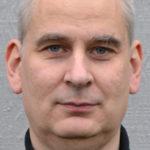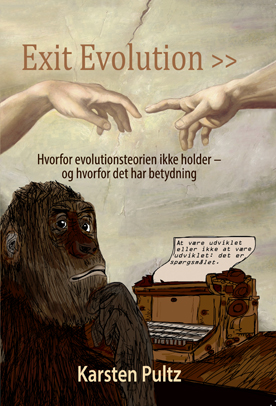
Our Danish friend, Karsten Pultz (left), author of Exit Evolution, tackles the big question;
This is the important question ID raises against the neo-Darwinian claim that life came about by random processes. Here I offer some thoughts about the connection between information in the form of digital codes and the products they code for. I thus hope to support the argument for ID and for what seems to me the inescapable fact of teleology in nature.
If a random number generator were set to produce eight digit numbers, and it coincidentally spat out 87958007, which happens to be my phone number, would it then have produced information? Or if a prebiotic soup randomly produced a functional protein, or a string of DNA that coded for a protein (ignoring the low probability of such occurrences), would the soup have produced information?
I would argue no.
The specific sequences that carry information, phone numbers, for example, can only be defined as information in relation to the whole system of which they are a part. There needs to be a translation system with defined rules that sorts out which sequences contains information and which do not.
To claim that information in DNA could arise by random chance is therefore nonsense. A functional sequence could not be regarded as information until we have a complete set of rules which defines that certain sequences are functional and all others are nonfunctional gobbledygook.
It is not reasonable to consider it likely that information can arise by chance without the translation that defines it as information?
A random process producing information is an oxymoron
No matter how many phone numbers that happen to be in service that a random number generator spits out, they wouldn’t be phone numbers because the generator has not chosen them from a defined set of rules. In the same way, proteins randomly produced in a prebiotic soup would not be proteins at all because they would not have been produced in relation to the translation system which defines them as proteins. Equally important, they would not have been produced in relation to the specific task they would serve in an organism.

Phone numbers are only phone numbers because we, the intelligent designers, have made the rules that decide what is required in order for a sequence of digits to function as an actual phone number.
Talking about information detached from the translation system which defines it as information doesn’t make sense.
We don’t get information without the act of choice, a feature that is related only to intelligent agency. A random process producing information is therefore an oxymoronic (or just moronic) concept. The translation system that defines what sequences are functional is obviously intelligently designed because it involves the conscious selection of parameters.
The information-product connection
Not only is the problem that there aren’t enough probabilistic resources to produce the DNA code by random processes but the DNA code would in fact not be information without the translation system. The code, together with the translation system, would still be worthless if it weren’t strictly tied to the last part of the overall system, namely the product, the organism.
In the end, it is the final product that defines that the information which forms the basis of the product can be considered information in the first place.
Code-translation-product
In a modern car factory we have the three part production system which consists of computer code, the machinery (robots) that translate the code into specific movements, and finally the end product, the car. It is obvious that the intelligent designers did not start with the two first items, the code and the translation. It was the final product which initially was in the mind of the intelligent designers. The code and the translation tools were developed in coordination to realize the idea of a car, the idea of which initially was in the mind of the intelligent designer.
Hence I will argue that information is only information if it is related to the end product. The idea (logos) comes first, then secondly the coding and the translation tools are put together simultaneously in order to realize the idea.
I think it is reasonable to argue that information is necessarily tied to a product, an idea (logos) or message, and that the product always is in the mind of the intelligent designer as the first thing. Information can therefore not be the product of a mindless process.
Human-engineered factory production is characterized by initially having a desired object in mind. After the inception of the idea, robots are built that can produce the object, and lastly the coding that is going to operate the machinery is done. The important thing here is that the idea of the end product comes first; the translation (the machinery) and the coding comes after inception of the idea.
A code—which is what we call information—is nothing in itself because it is slave to the idea. I would argue that the same counts for living things, that the DNA code was set up to realize and idea, an organism the intelligent designer already had in mind.
Identifying that something is wrong
It is the end product that defines whether a code sequence carries (“correct”) information or not. If cars leave the production line with only three wheels or with just one headlight, we become aware that something is wrong with the underlying information. So that is how we can evaluate if something can be regarded as information, simply by looking at the end product.
The materialist cannot escape the fact of teleology in nature, because even he or she will recognize illness and defect as something that is “wrong” with an organism, thereby acknowledging the overall idea and purpose of an organism.
When it comes to information the process always starts with an idea in a mind. The information that’s needed to realize the idea is defined by the idea, not the other way around. This makes it unlikely that information could arise by mindless natural processes, because we need a mind with an idea before we come to the part we call information.
Because human engineers, the only intelligent designers we are familiar with, operate in the described way, with the idea as the primary and the translation and coding as secondary, we have an empirical basis for arguing that life is the product of an idea in the mind of an intelligent designer.
The idea is primary
In human engineering you start with the end-product in mind, for instance a car. Then you set up the machinery that can produce the wanted item, and lastly you program the machinery. In written language you also start with the end-product, namely the message you want to convey, and then you do the “programming”, the sequencing of letters which follows the in advance chosen rules. It is not possible to look at information separated from the translation and the end product. The three parts, code-translation-product, are inherently connected, the idea, product or message in the mind of the intelligent designer being the first to arise.
So even if the chances of a protein arising in a prebiotic soup were not out of reach, it would still not be a protein because a protein is defined by its function in the end-product, the organism. A DNA sequence can only be defined as information if you already have the organism in view. Therefore it makes sense that in the beginning was the idea, the logos.
Conclusion
I think my argument shows that idealism is true and materialism is false, that random processes do not produce information, and that a mind with an idea is the primary means by which everything comes into existence. One can use it to argue for ID and for teleology in nature. I would also not hesitate to use it as argument in a theological debate.
See also: Karsten Pultz: The perils of talking about ID He wonders, should he give up?